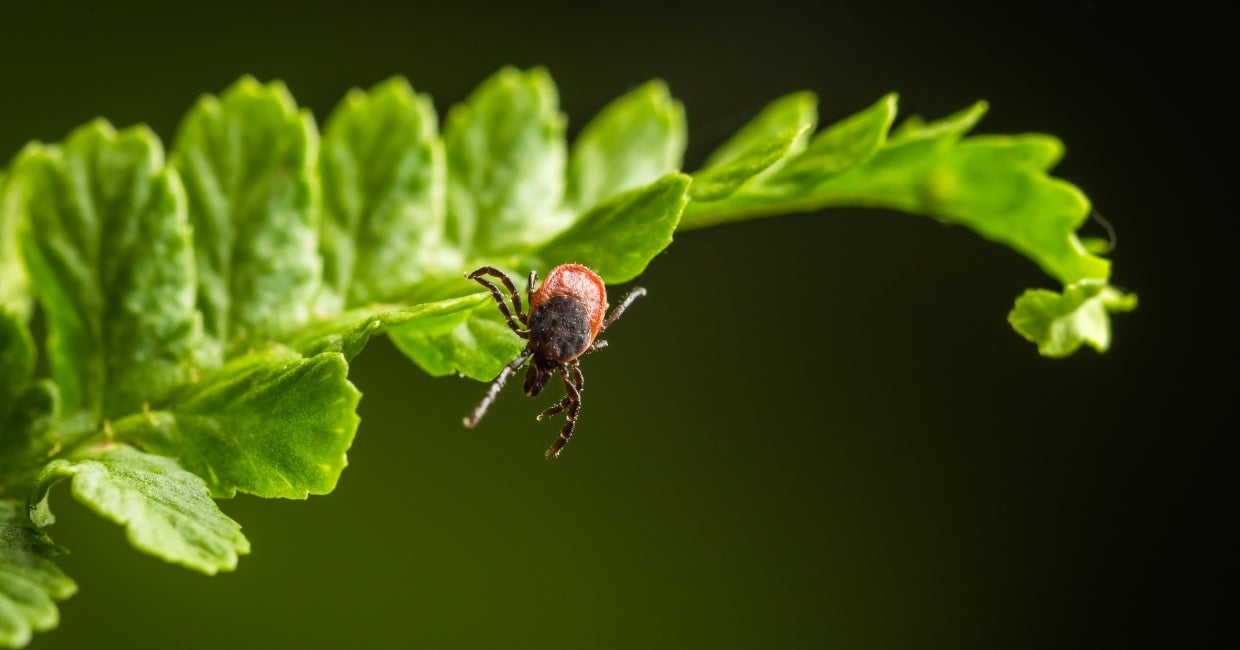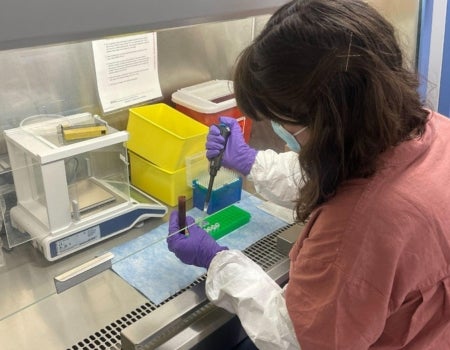A Pennsylvania study of deer and ticks at the University of Pennsylvania School of Veterinary Medicine could shape public health and safety across the Commonwealth

Faculty In This Story
Despite their small size, ticks are among the most dangerous animals encountered in the wild due to their ability to transmit zoonotic infections to humans, domestic animals, and wildlife. In the United States, nine tick species carry pathogenic viruses, bacteria, and parasites, with the blacklegged deer tick (Ixodes scapularis) being the primary vector of infection. Lyme disease, the most prevalent tickborne disease in the US, has been on the rise over the past two decades, with rates quadrupling in endemic areas of the Northeast, Mid-Atlantic, and the Upper Midwest. Pennsylvania faces a disproportionate burden, with over 60,000 lab-confirmed canine cases and more than 11,000 human cases reported in 2024.
Tracking Ticks to Protect Pennsylvanians from Hidden Outdoor Threats
A multi-year research initiative to identify pathogens in Pennsylvania’s white-tailed deer and their associated ticks could shape public health and safety across the Commonwealth. Researchers at the University of Pennsylvania’s School of Veterinary Medicine (Penn Vet), in collaboration with the Pennsylvania Game Commission, are studying the complex interactions between ticks, pathogens, hosts, and their environment. Led by ecologist Julie Ellis, PhD, of the Wildlife Futures Program (WFP) along with investigators from the Institute for Infectious and Zoonotic Diseases (IIZD) and the Center for Host-Microbial Interactions (CHMI), the study aims to survey the presence and distribution of pathogens, and to understand the dynamics of tickborne disease transmission in wildlife.

Penn Vet student, Shelby Monnin, V’26, has spent two summers identifying the species, sex, and age of hundreds of ticks collected from over 60 hunter-harvested or culled deer by WFP’s wildlife health technicians. Most were blacklegged ticks (Ixodes scapularis), the primary vector of Lyme disease in the eastern United States. However, 45% were Asian longhorned ticks (Haemaphysalis longicornis), an invasive species first found in New Jersey in 2017 and now established in 17 states. Monnin also identified lone star ticks (Amblyomma americanum), the bites of which are responsible for alpha-gal syndrome (red meat allergy).
In CHMI’s lab, Monnin performed quantitative PCR (qPCR) on individual ticks and deer blood to detect specific pathogens. Several samples tested positive for Borrelia burgdorferi (Lyme disease), Anaplasma phagocytophilum (anaplasmosis, a bacterial disease), and Babesia microti (babesiosis, a parasitic disease of red blood cells), all of which are known to infect humans and animals in the region. A subset of ticks also underwent shotgun metagenomic sequencing, a technique that allows for the untargeted detection of microbes within a sample. The metagenomic results confirmed those of the qPCR but also revealed the presence of bacterial endosymbionts, or organisms that live within the bodies of other organisms.
During the second year of the study, Asian longhorned ticks became a focus due to their high abundance in the Philadelphia region and the limited understanding of their role in transmitting tickborne diseases in the United States. By linking each deer and tick sample to their specific geographic origins within Pennsylvania, the team was able to identify hotspots for pathogens. The public health implications of this pathogen mapping are significant, as humans, domestic animals, and wildlife in each area face varying levels of risk for tickborne illnesses if a tick bites them.
Leading the Charge in Targeted Prevention
The surge in tickborne diseases over the past two decades, partly attributed to human activities, underscores the need for innovative mitigation strategies. By spatially mapping ticks and associated pathogens across Pennsylvania, this study offers a foundation for understanding where geographic risk is concentrated within the Commonwealth. The intent is to guide targeted interventions, public health messaging, and land and wildlife management practices to reduce exposure and transmission of tickborne diseases.
“This project is of the utmost importance when considering the dynamics of humans, animals, and the environment,” said Monnin. “We know now, better than ever, that the biggest threats to human health come from our own interactions with wild spaces. As we continue to impose on these spaces, our greatest predictive strengths are vector and disease surveillance.”
Tick Prevention and Testing Resources
Ticks are active when the temperature is above freezing, but their activity intensifies during the warmer months. Late-spring and summer are peak Lyme season, with the highest transmission occurring between May and August. Most tick encounters occur on or around homeowners’ property.
Here are tips for prevention:
- Treat clothes, shoes, and outdoor gear with permethrin. Be cautious when using permethrin, the synthetic insecticide used to control fleas and ticks, around cats.
- Wear light-colored clothing, tuck pants into socks, and use insect repellent.
- Dry clothes on high heat for 5–10 minutes after being outdoors.
- Check for ticks within two hours of coming inside.
- Avoid tick-heavy areas.
- Protect pets with a tick preventative.
- Remove invasive plants such as Japanese barberry, Japanese honeysuckle, and English ivy from your property. These plants provide excellent habitat for ticks and the white-footed mouse, the primary reservoir for the Lyme disease bacteria.
What should you do if you discover a tick attached to yourself or your pet?
- Remove: Prompt removal is crucial for minimizing the risk of pathogen transmission. IIZD researchers prefer using a Tick Key or other similar tool for easy and clean removal.
- Clean: Wash the wound with soap and water or disinfect with rubbing alcohol.
- Monitor: Over the next 30 days, monitor for rash (especially bullseye), fever, lethargy, and joint pain. Consult with a healthcare provider or veterinarian as needed. Use the Tick Bot if unsure about seeking (human) care.
- Test: The Clinical Infectious Disease (CID) Lab at Penn Vet offers a comprehensive vector-borne disease panel that uses both molecular and serological methods to detect key pathogens in dogs and cats. Pennsylvania residents are also eligible for free basic testing at the Pennsylvania Tick Research Lab. Mail them your tick and receive results for multiple tickborne diseases within a few days.
Julie Ellis, PhD, is an Adjunct Associate Professor of Pathobiology and Senior Research Investigator in the Department of Pathobiology in the School of Veterinary Medicine; Associate Director, IIZD; Wildlife Ecologist, WFP; and Faculty Director of Penn’s Environmental Innovations Initiative.
Dan Beiting, PhD, is an Associate Professor of Pathobiology in the Department of Pathobiology in the School of Veterinary Medicine; Associate Director, IIZD; Technical Director, CHMI
Erick Gagne, PhD, is an Assistant Professor of Wildlife Disease Ecology in the Department of Pathobiology in the School of Veterinary Medicine.
Lisa Mattei, PhD, is a Senior Research Investigator in the Department of Pathobiology in the School of Veterinary Medine; Director of Operations, IIZD.
Erica Miller, DVM, Field Operations Manager, WFP.
Shelby Monnin, veterinary student in the School of Veterinary Medicine.
This work was supported by the Richard King Mellon Foundation; and the Penn NIH/Boehringer Ingelheim Summer Research Program (Monnin).
Related News

Behind the Breakthroughs: J. Oriol Sunyer
J. Oriol Sunyer explores how studying the evolution of the immune system reveals surprising connections between fish and human immunity, and what these discoveries could mean for the development of…

Penn Vet’s Institute for Infectious and Zoonotic Diseases Hosts Second Annual Research Retreat
The University of Pennsylvania (Penn) School of Veterinary Medicine’s (Penn Vet) Institute for Infectious and Zoonotic Diseases (IIZD) hosted its annual Faculty Research Retreat on September 3 at the Brandywine…

A New Study from Penn Vet Reveals an Unsung Immune Defender as a Key Guardian of Gut Health and Metabolism
A pioneering new study published in Nature Microbiology, led by Oriol Sunyer, PhD, and a team of researchers at Penn Vet and the University of New Mexico, have uncovered a…
About Penn Vet
Ranked among the top ten veterinary schools worldwide, the University of Pennsylvania School of Veterinary Medicine (Penn Vet) is a global leader in veterinary education, research, and clinical care. Founded in 1884, Penn Vet is the first veterinary school developed in association with a medical school. The school is a proud member of the One Health initiative, linking human, animal, and environmental health.
Penn Vet serves a diverse population of animals at its two campuses, which include extensive diagnostic and research laboratories. Ryan Hospital in Philadelphia provides care for dogs, cats, and other domestic/companion animals, handling more than 30,000 patient visits a year. New Bolton Center, Penn Vet’s large-animal hospital on nearly 700 acres in rural Kennett Square, PA, cares for horses and livestock/farm animals. The hospital handles more than 6,300 patient visits a year, while our Field Services have gone out on more than 5,500 farm service calls, treating some 22,400 patients at local farms. In addition, New Bolton Center’s campus includes a swine center, working dairy, and poultry unit that provide valuable research for the agriculture industry.



